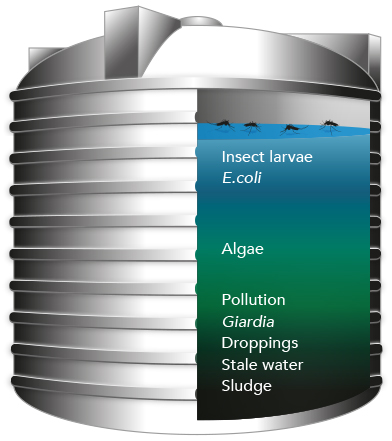Harvesting and storing rainwater is a simple and efficient way to provide a safe, natural water supply. Being a free resource, it also makes great financial and environmental sense. But you also need to ensure the rainwater you store in your water tank remains clean, fresh and safe. In the past this has meant either paying a professional or attempting the difficult task of cleaning the water tank yourself.
Introducing the permanent, hassle-free alternative – TankVac®!
Why do you need TankVac?
Maintaining the quality of stored rainwater is a never-ending challenge due to waste and sediment accumulation, creating a breeding ground for harmful bacteria like E.coli, Giardia, and Salmonella. These bacteria can cause serious health issues like vomiting, stomach cramps, and diarrhea. Filtering at the tap only collects the outer membranes of these harmful bacteria. Installing a TankVac® system eliminates smells and harmful bacteria, providing fresh and sparkling rainwater.
Development
The engineering team at Waikato University, led by Dr. Michael Walmsley, conducted research in their modern large-scale development laboratory to determine the optimal design for our tank water treatment system.
Trials
Dr. David Bryant and Dr. Walmsley’s team collaborated to examine the impact of base overflow on water quality in six test tanks made of concrete and polyethylene in the Auckland area. Dr. Bryant took two water samples from each tank, one from the sediment/water on the tank floor and the other from the water just below the surface at the top of the tank. E. coli levels were of particular interest and were found to be higher in the sediment than the surface water.
After installation of the TankVac® System and a heavy weekend of rain, the researchers revisited the test sites and collected water samples from both the base and near the surface. The samples were analyzed again, and the results were surprising – the E. coli levels in both locations were zero. The TankVac® system significantly reduced microbial load and eliminated odors by removing sediment and microorganisms from the tank bottom.
Dr. Bryant had a water filter in his Karekare home, which was replaced every two months by a contractor. One day, the contractor phoned Dr. Bryant to inquire if he had changed the filter himself, as it appeared brand new but was due for replacement. Dr. Bryant realized that the TankVac® was significantly impacting the life of his water filter.
Without a TankVac®, particles of plant material are drawn into the water pump, sucked up by the mechanism, and pushed directly into the filter. It was evident that with a TankVac® installed, the life of the filter was significantly prolonged. Therefore, it is clear that base overflow has a direct impact on the quality of tank-stored rainwater.

